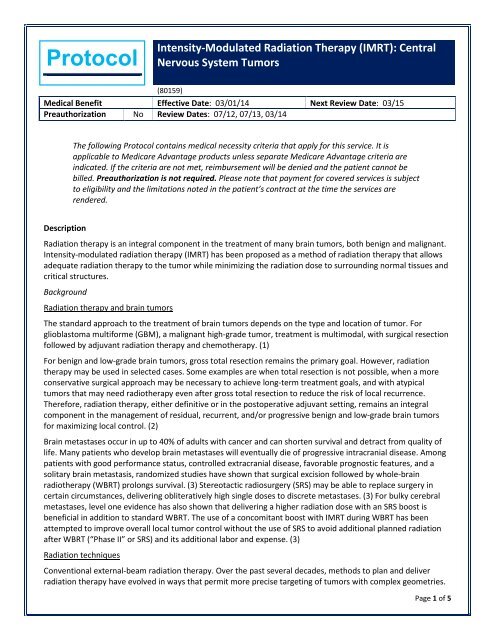Intensity-Modulated Radiation Therapy (IMRT): Central Nervous ...
Intensity-Modulated Radiation Therapy (IMRT): Central Nervous ...
Intensity-Modulated Radiation Therapy (IMRT): Central Nervous ...
You also want an ePaper? Increase the reach of your titles
YUMPU automatically turns print PDFs into web optimized ePapers that Google loves.
Protocol<br />
<strong>Intensity</strong>-<strong>Modulated</strong> <strong>Radiation</strong> <strong>Therapy</strong> (<strong>IMRT</strong>): <strong>Central</strong><br />
<strong>Nervous</strong> System Tumors<br />
(80159)<br />
Medical Benefit Effective Date: 03/01/14 Next Review Date: 03/15<br />
Preauthorization No Review Dates: 07/12, 07/13, 03/14<br />
The following Protocol contains medical necessity criteria that apply for this service. It is<br />
applicable to Medicare Advantage products unless separate Medicare Advantage criteria are<br />
indicated. If the criteria are not met, reimbursement will be denied and the patient cannot be<br />
billed. Preauthorization is not required. Please note that payment for covered services is subject<br />
to eligibility and the limitations noted in the patient’s contract at the time the services are<br />
rendered.<br />
Description<br />
<strong>Radiation</strong> therapy is an integral component in the treatment of many brain tumors, both benign and malignant.<br />
<strong>Intensity</strong>-modulated radiation therapy (<strong>IMRT</strong>) has been proposed as a method of radiation therapy that allows<br />
adequate radiation therapy to the tumor while minimizing the radiation dose to surrounding normal tissues and<br />
critical structures.<br />
Background<br />
<strong>Radiation</strong> therapy and brain tumors<br />
The standard approach to the treatment of brain tumors depends on the type and location of tumor. For<br />
glioblastoma multiforme (GBM), a malignant high-grade tumor, treatment is multimodal, with surgical resection<br />
followed by adjuvant radiation therapy and chemotherapy. (1)<br />
For benign and low-grade brain tumors, gross total resection remains the primary goal. However, radiation<br />
therapy may be used in selected cases. Some examples are when total resection is not possible, when a more<br />
conservative surgical approach may be necessary to achieve long-term treatment goals, and with atypical<br />
tumors that may need radiotherapy even after gross total resection to reduce the risk of local recurrence.<br />
Therefore, radiation therapy, either definitive or in the postoperative adjuvant setting, remains an integral<br />
component in the management of residual, recurrent, and/or progressive benign and low-grade brain tumors<br />
for maximizing local control. (2)<br />
Brain metastases occur in up to 40% of adults with cancer and can shorten survival and detract from quality of<br />
life. Many patients who develop brain metastases will eventually die of progressive intracranial disease. Among<br />
patients with good performance status, controlled extracranial disease, favorable prognostic features, and a<br />
solitary brain metastasis, randomized studies have shown that surgical excision followed by whole-brain<br />
radiotherapy (WBRT) prolongs survival. (3) Stereotactic radiosurgery (SRS) may be able to replace surgery in<br />
certain circumstances, delivering obliteratively high single doses to discrete metastases. (3) For bulky cerebral<br />
metastases, level one evidence has also shown that delivering a higher radiation dose with an SRS boost is<br />
beneficial in addition to standard WBRT. The use of a concomitant boost with <strong>IMRT</strong> during WBRT has been<br />
attempted to improve overall local tumor control without the use of SRS to avoid additional planned radiation<br />
after WBRT (“Phase II” or SRS) and its additional labor and expense. (3)<br />
<strong>Radiation</strong> techniques<br />
Conventional external-beam radiation therapy. Over the past several decades, methods to plan and deliver<br />
radiation therapy have evolved in ways that permit more precise targeting of tumors with complex geometries.<br />
Page 1 of 5
Protocol<br />
<strong>Intensity</strong>-<strong>Modulated</strong> <strong>Radiation</strong> <strong>Therapy</strong> (<strong>IMRT</strong>): <strong>Central</strong> <strong>Nervous</strong><br />
System Tumors<br />
Last Review Date: 03/14<br />
Most early trials used two-dimensional treatment planning based on flat images and radiation beams with crosssections<br />
of uniform intensity that were sequentially aimed at the tumor along two or three intersecting axes.<br />
Collectively, these methods are termed “conventional external-beam radiation therapy.”<br />
3-dimensional conformal radiation therapy (3D-CRT). Treatment planning evolved by using 3-dimensional<br />
images, usually from computed tomography (CT) scans, to delineate the boundaries of the tumor and<br />
discriminate tumor tissue from adjacent normal tissue and nearby organs at risk for radiation damage.<br />
Computer algorithms were developed to estimate cumulative radiation dose delivered to each volume of<br />
interest by summing the contribution from each shaped beam. Methods also were developed to position the<br />
patient and the radiation portal reproducibly for each fraction and immobilize the patient, thus maintaining<br />
consistent beam axes across treatment sessions. Collectively, these methods are termed 3-dimensional<br />
conformal radiation therapy (3D-CRT).<br />
<strong>Intensity</strong>-modulated radiation therapy (<strong>IMRT</strong>). <strong>IMRT</strong>, which uses computer software and CT and magnetic<br />
resonance imaging (MRI) images, offers better conformality than 3D-CRT, as it is able to modulate the intensity<br />
of the overlapping radiation beams projected on the target and to use multiple shaped treatment fields. It uses a<br />
device (a multileaf collimator, MLC) which, coupled to a computer algorithm, allows for “inverse” treatment<br />
planning. The radiation oncologist delineates the target on each slice of a CT scan and specifies the target’s<br />
prescribed radiation dose, acceptable limits of dose heterogeneity within the target volume, adjacent normal<br />
tissue volumes to avoid, and acceptable dose limits within the normal tissues. Based on these parameters and a<br />
digitally reconstructed radiographic image of the tumor and surrounding tissues and organs at risk, computer<br />
software optimizes the location, shape and intensities of the beams ports, to achieve the treatment plan’s goals.<br />
Increased conformality may permit escalated tumor doses without increasing normal tissue toxicity and thus<br />
may improve local tumor control, with decreased exposure to surrounding, normal tissues, potentially reducing<br />
acute and late radiation toxicities. Better dose homogeneity within the target may also improve local tumor<br />
control by avoiding underdosing within the tumor and may decrease toxicity by avoiding overdosing.<br />
Since most tumors move as patients breathe, dosimetry with stationary targets may not accurately reflect doses<br />
delivered within target volumes and adjacent tissues in patients. Furthermore, treatment planning and delivery<br />
are more complex, time-consuming, and labor-intensive for <strong>IMRT</strong> than for 3D-CRT. Thus, clinical studies must<br />
test whether <strong>IMRT</strong> improves tumor control or reduces acute and late toxicities when compared with 3D-CRT.<br />
Methodological issues with <strong>IMRT</strong> studies<br />
Multiple-dose planning studies have generated 3D-CRT and <strong>IMRT</strong> treatment plans from the same scans, then<br />
compared predicted dose distributions within the target and in adjacent organs at risk. Results of such planning<br />
studies show that <strong>IMRT</strong> improves on 3D-CRT with respect to conformality to, and dose homogeneity within, the<br />
target. Dosimetry using stationary targets generally confirms these predictions. Thus, radiation oncologists<br />
hypothesized that <strong>IMRT</strong> may improve treatment outcomes compared with those of 3D-CRT. However, these<br />
types of studies offer indirect evidence on treatment benefit from <strong>IMRT</strong>, and it is difficult to relate results of<br />
dosing studies to actual effects on health outcomes.<br />
Comparative studies of radiation-induced side effects from <strong>IMRT</strong> versus alternative radiation delivery are<br />
probably the most important type of evidence in establishing the benefit of <strong>IMRT</strong>. Such studies would answer<br />
the question of whether the theoretical benefit of <strong>IMRT</strong> in sparing normal tissue translates into real health<br />
outcomes. Single-arm series of <strong>IMRT</strong> can give some insights into the potential for benefit, particularly if an<br />
adverse effect that is expected to occur at high rates is shown to decrease by a large amount. Studies of<br />
treatment benefit are also important to establish that <strong>IMRT</strong> is at least as good as other types of delivery, but in<br />
the absence of such comparative trials, it is likely that benefit from <strong>IMRT</strong> is at least as good as with other types<br />
of delivery.<br />
Page 2 of 5
Protocol<br />
<strong>Intensity</strong>-<strong>Modulated</strong> <strong>Radiation</strong> <strong>Therapy</strong> (<strong>IMRT</strong>): <strong>Central</strong> <strong>Nervous</strong><br />
System Tumors<br />
Last Review Date: 03/14<br />
Regulatory Status<br />
The U.S. Food and Drug Administration (FDA) has approved a number of devices for use in intensity-modulated<br />
radiation therapy (<strong>IMRT</strong>), including several linear accelerators and multileaf collimators. Examples of approved<br />
devices and systems are the NOMOS Slit Collimator (BEAK) (NOMOS Corp.), the Peacock System (NOMOS<br />
Corp.), the Varian Multileaf Collimator with dynamic arc therapy feature (Varian Oncology Systems), the Saturne<br />
Multileaf Collimator (GE Medical Systems), the Mitsubishi 120 Leaf Multileaf Collimator (Mitsubishi Electronics<br />
America Inc.), the Stryker Leibinger Motorized Micro Multileaf Collimator (Stryker Leibinger), the Mini Multileaf<br />
Collimator, model KMI (MRC Systems GMBH), and the Preference® <strong>IMRT</strong> Treatment Planning Module<br />
(Northwest Medical Physics Equipment Inc.).<br />
Related Protocols<br />
<strong>Intensity</strong>-<strong>Modulated</strong> <strong>Radiation</strong> <strong>Therapy</strong> (<strong>IMRT</strong>): Cancer of the Head and Neck or Thyroid<br />
<strong>Intensity</strong>-<strong>Modulated</strong> <strong>Radiation</strong> <strong>Therapy</strong> (<strong>IMRT</strong>): Abdomen and Pelvis<br />
Policy (Formerly Corporate Medical Guideline)<br />
<strong>Intensity</strong>-modulated radiation therapy (<strong>IMRT</strong>) may be considered medically necessary for the treatment of<br />
tumors of the central nervous system when the tumor is in close proximity to organs at risk (brain stem, spinal<br />
cord, cochlea and eye structures including optic nerve and chiasm, lens and retina) and 3-D CRT planning is not<br />
able to meet dose volume constraints for normal tissue tolerance. (see Policy Guidelines)<br />
<strong>IMRT</strong> for central nervous system tumors not meeting these criteria would be considered not medically<br />
necessary.<br />
Policy Guideline<br />
Organs at risk are defined as normal tissues whose radiation sensitivity may significantly influence treatment<br />
planning and/or prescribed radiation dose. These organs at risk may be particularly vulnerable to clinically<br />
important complications from radiation toxicity. The following table outlines radiation doses that are generally<br />
considered tolerance thresholds for these normal structures in the CNS.<br />
<strong>Radiation</strong> tolerance doses for normal tissues<br />
TD 5/5 (Gy) a<br />
TD 50/5 (Gy) b<br />
Portion of organ involved Portion of organ involved<br />
Site 1/3 2/3 3/3 1/3 2/3 3/3 Complication End Point<br />
Brain stem 60 53 50 NP NP 65 Necrosis, infarct<br />
Spinal cord 50 (5-10 cm) NP 47 (20 cm) 70 (5-10 cm) NP NP Myelitis, necrosis<br />
Optic nerve and 50 50 50 65 65 65 Blindness<br />
chiasm<br />
Retina 45 45 45 65 65 65 Blindness<br />
Eye lens 10 10 10 18 18 18 Cataract requiring<br />
intervention<br />
<strong>Radiation</strong> tolerance doses for the cochlea have been reported to be 50 Gy<br />
a TD 5/5, the average dose that results in a 5% complication risk within five years<br />
b TD 50/5, the average dose that results in a 50% complication risk within five years<br />
NP: not provided<br />
cm=centimeters<br />
Page 3 of 5
Protocol<br />
<strong>Intensity</strong>-<strong>Modulated</strong> <strong>Radiation</strong> <strong>Therapy</strong> (<strong>IMRT</strong>): <strong>Central</strong> <strong>Nervous</strong><br />
System Tumors<br />
Last Review Date: 03/14<br />
The tolerance doses in the table are a compilation from the following two sources:<br />
Morgan MA (2011). <strong>Radiation</strong> Oncology. In DeVita, Lawrence and Rosenberg, Cancer (p.308). Philadelphia:<br />
Lippincott Williams and Wilkins.<br />
Kehwar TS, Sharma SC. Use of normal tissue tolerance doses into linear quadratic equation to estimate normal<br />
tissue complication probability. http://www.rooj.com/<strong>Radiation</strong>%20Tissue%20Tolerance.htm<br />
Note: This Protocol does not address radiation treatment for metastasis to the brain or spine.<br />
Services that are the subject of a clinical trial do not meet our Technology Assessment Protocol criteria and are<br />
considered investigational. For explanation of experimental and investigational, please refer to the Technology<br />
Assessment Protocol.<br />
It is expected that only appropriate and medically necessary services will be rendered. We reserve the right to<br />
conduct prepayment and postpayment reviews to assess the medical appropriateness of the above-referenced<br />
procedures. Some of this Protocol may not pertain to the patients you provide care to, as it may relate to<br />
products that are not available in your geographic area.<br />
References<br />
We are not responsible for the continuing viability of web site addresses that may be listed in any references<br />
below.<br />
1. Amelio D, Lorentini S, Schwarz M et al. <strong>Intensity</strong>-modulated radiation therapy in newly diagnosed<br />
glioblastoma: a systematic review on clinical and technical issues. Radiother Oncol 2010; 97(3):361-9.<br />
2. Gupta T, Wadasadawala T, Master Z et al. Encouraging early clinical outcomes with helical tomotherapybased<br />
image-guided intensity-modulated radiation therapy for residual, recurrent, and/or progressive<br />
benign/low-grade intracranial tumors: a comprehensive evaluation. Int J Radiat Oncol Biol Phys 2012;<br />
82(2):756-64.<br />
3. Edwards AA, Keggin E, Plowman PN. The developing role for intensity-modulated radiation therapy (<strong>IMRT</strong>) in<br />
the non-surgical treatment of brain metastases. Br J Radiol 2010; 83(986):133-6.<br />
4. Fuller CD, Choi M, Forthuber B et al. Standard fractionation intensity modulated radiation therapy (<strong>IMRT</strong>) of<br />
primary and recurrent glioblastoma multiforme. Radiat Oncol 2007; 2:26.<br />
5. MacDonald SM, Ahmad S, Kachris S et al. <strong>Intensity</strong> modulated radiation therapy versus three-dimensional<br />
conformal radiation therapy for the treatment of high grade glioma: a dosimetric comparison. J Appl Clin<br />
Med Phys 2007; 8(2):47-60.<br />
6. Narayana A, Yamada J, Berry S et al. <strong>Intensity</strong>-modulated radiotherapy in high-grade gliomas: clinical and<br />
dosimetric results. Int J <strong>Radiation</strong> Oncology Biol Phys 2006; 64(3):892-7.<br />
7. Huang E, The BS, Strother DR et al. <strong>Intensity</strong>-modulated radiation therapy for pediatric medulloblastoma:<br />
early report on the reduction of ototoxicity. Int J Radiat Oncol Biol Phys 2002; 52(3):599-605.<br />
8. Milker-Zabel S, Zabel-du BA, Huber P et al. <strong>Intensity</strong>-modulated radiotherapy for complex-shaped<br />
meningioma of the skull base: long-term experience of a single institution. Int J Radiat Oncol Biol Phys 2007;<br />
68(3):858-63.<br />
Page 4 of 5
Protocol<br />
<strong>Intensity</strong>-<strong>Modulated</strong> <strong>Radiation</strong> <strong>Therapy</strong> (<strong>IMRT</strong>): <strong>Central</strong> <strong>Nervous</strong><br />
System Tumors<br />
Last Review Date: 03/14<br />
9. Mackley HB, Reddy CA, Lee SY et al. <strong>Intensity</strong>-modulated radiotherapy for pituitary adenomas: the<br />
preliminary report of the Cleveland Clinic experience. Int J Radiat Oncol Biol Phys 2007; 67(1):232-9.<br />
10. Sajja R, Barnett GH, Lee SY et al. <strong>Intensity</strong>-modulated radiation therapy (<strong>IMRT</strong>) for newly diagnosed and<br />
recurrent intracranial meningiomas: preliminary results. Technol Cancer Res Treat 2005; 4(6):675-82.<br />
11. Uy NW, Woo SY, Teh BS et al. <strong>Intensity</strong>-modulated radiation therapy (<strong>IMRT</strong>) for meningioma. Int J Radiat<br />
Oncol Biol Phys 2002; 53(5):1265-70.<br />
12. National Comprehensive Cancer Network (NCCN) Guidelines. <strong>Central</strong> <strong>Nervous</strong> System Cancers (v1.2013).<br />
Available online at: http://www.nccn.org/professionals/physician_gls/PDF/cns.pdf. Last accessed March<br />
2013.<br />
Page 5 of 5

















